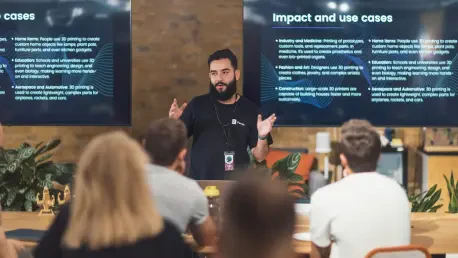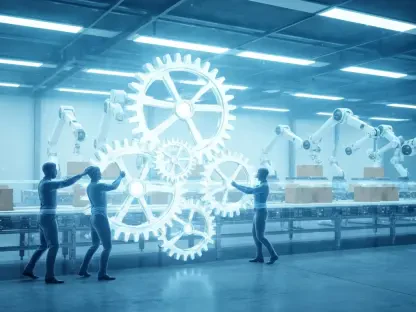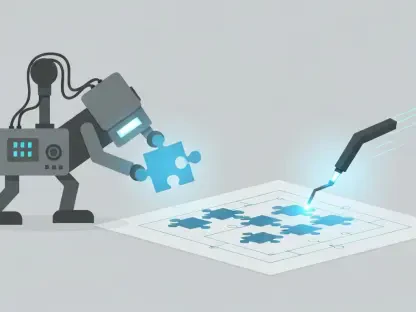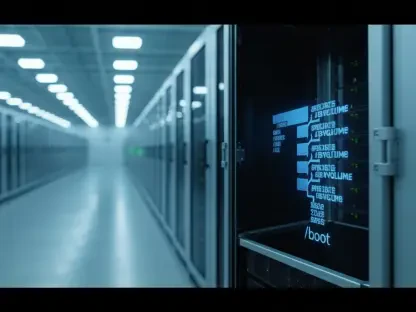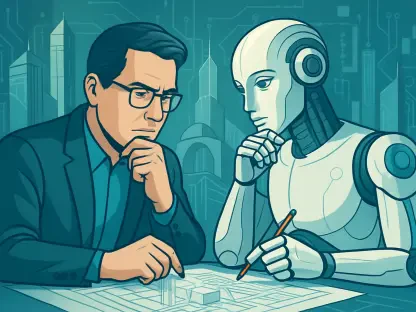In today’s fast-paced tech world, keeping abreast of advancements like AI is crucial. Vijay Raina, a seasoned expert in enterprise SaaS technology and software architecture, shares his insights into how these trends are shaping the industry. From AI’s role in software development to its impact on job roles, Vijay provides a nuanced perspective to help us navigate the current technological landscape.
Could you explain the current impact of AI on the software development industry, particularly with tools like GitHub Copilot?
AI has created a seismic shift in software development, transforming processes once strictly carried out by developers. Tools like GitHub Copilot are at the forefront of this change, assisting in writing code by providing suggestions and automating repetitive tasks. According to Microsoft, more than 30% of the code on GitHub Copilot is AI-generated, indicating a significant move toward integrating AI in coding practices. This shift not only speeds up development but also opens the door to innovative coding solutions.
What are some of the key factors contributing to layoffs in major tech companies?
Layoffs in large tech firms have been influenced by a combination of economic downturns, decreased consumer demand, and strategic restructuring. Economic challenges have forced companies to reassess their workforce needs, often leading to significant job cuts. Additionally, strategic restructuring aims to optimize operations, sometimes resulting in layoffs to eliminate redundancy and streamline processes, ensuring the company remains competitive.
How are current generative AI models, like GPT-4 and CodeWhisperer, influencing job roles in tech?
Generative AI models such as GPT-4 and CodeWhisperer are reshaping tech roles by automating tasks that involve predictable and well-defined work. These models excel in generating code snippets, documentation, and even debugging, allowing developers to focus on more complex tasks. However, their limitation lies in creativity and independent ideation—AI still relies on human input to guide and refine its output, which means there’s no complete replacement for human intelligence yet.
What is the relationship between AI adoption and productivity growth in various occupations?
AI adoption correlates strongly with productivity growth across different industries. Sectors that embrace high levels of AI integration experience nearly five times the productivity growth compared to those with minimal AI use. Nevertheless, AI systems still require human prompts, underscoring the need for a collaborative approach. The technology’s capabilities, while vast, depend on human direction for effective deployment and interpretation of tasks.
Can you discuss the World Economic Forum’s findings about job displacement and creation due to AI?
The World Economic Forum predicts that 40% of employers plan to reduce their workforce due to AI’s automation capabilities. However, AI also creates new opportunities by enabling the development of roles centered around AI strategy, oversight, and ethics. It facilitates the emergence of jobs that address AI’s integration into business processes, opening new career avenues across various industries.
What does the data show about tech industry layoffs over the past few years?
Recent data reveals significant fluctuations in tech industry employment, influenced by pivotal events like the COVID-19 pandemic. Initially, the pandemic drove a hiring surge to cater to the burgeoning digital demand. By early 2023, however, a downturn led to over 200,000 tech jobs being axed. These layoffs were largely driven by a combination of performance evaluations, budget constraints, and impactful strategic changes within companies.
How has the trend in tech job openings been affected despite widespread layoffs?
Despite widespread layoffs, the tech job market remains robust. As of mid-2025, there are approximately 238,000 open positions in the sector. This ongoing demand highlights a paradox: while companies streamline their existing workforce, they also seek fresh talent with advanced skills to drive future growth. The US Bureau of Labor Statistics forecasts over 356,700 tech job openings annually through 2033, emphasizing the industry’s sustained vitality.
How have skill requirements in tech companies evolved since 2015?
Since 2015, skill requirements in tech have evolved significantly, reflecting a 25% shift. This change is expected to double by 2027, signifying an accelerated pace of evolution. Employers now prioritize technical skills, with 59% of listings highlighting their importance over soft skills. This shift suggests a heightened focus on advanced technical proficiency as a critical hiring factor in a rapidly advancing industry.
What trends are visible concerning AI-related expertise in job postings?
The demand for AI-related expertise in tech roles has surged tremendously since 2022, now found in 19% to 25% of job postings in 2025. This trend highlights AI’s deepening integration within various industries. Skills like proficiency in Python, computer science, data analysis, and cloud platforms such as Amazon Web Services are increasingly sought after, reflecting the industry’s strategic pivot toward AI competence.
How can professionals adapt to the rapid pace of technological change, particularly with AI integration?
Adaptation to rapid technological change requires a proactive approach to skill development. Professionals should remain open to learning new tools and emerging trends, particularly in AI. Reflecting on past shifts, such as the move toward data engineering in the 2010s, shows the importance of versatility. By anticipating industry needs and continuously updating skills, individuals can ensure they remain competitive in the tech landscape.
